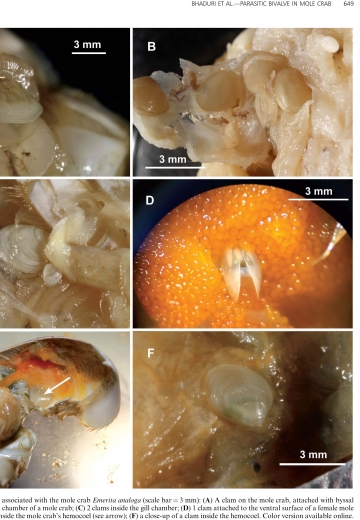Facultative parasitism by the bivalve Kurtiella pedroana in the mole crab Emerita analoga
Evolutionary transitions to parasitism are rare. In this study, we documented a potential step toward parasitism in the commensal clam Kurtiella pedroana (Bivalvia: Galeommatoidea). Galeommatoideans are known
commensals of various invertebrates, including crustaceans. Emerita analoga (Decapoda: Hippidae) is an abundant intertidal mole crab inhabiting Pacific coast beaches in North and South America.
Mole crabs collected from Monterey Bay, California, were measured and examined externally and internally for associated molluscs. Out of the 520 mole crabs, 37 large female individuals harbored 49 clams (prevalence of 7.11% and mean intensity of 1.3). Forty-one ectocommensal clams were attached by their byssal threads to the inside of the gill chambers or to the lateroventral surfaces.
However, our key finding was 8 clams that lacked byssal threads and were living in the hemocoel of 6 crabs. These internal clams were smaller than the ectocommensals. Because these internal clams lacked access to their normal food, we hypothesize they might have fed on hemolymph as would a parasite. Clam larvae have no obvious exit from the hemocoel, implying that endoparasitism is a dead-end for K. pedroana. Regardless, facultative parasitism in a freeliving or an ectocommensal is uncommon and suggests a pathway to parasitism.



